The advantages and cons of planting certain tree species in various situations are often questioned to me as a lover of trees and nature. The black gum tree is one of these trees that is commonly mentioned in these chats. This deciduous tree, often referred to as the tupelo tree, is a native of North America and has a number of benefits and disadvantages to consider before planting. In this article, we’ll take a closer look at the Black Gum Tree Pros and Cons when planting in your yard.
| Pros | Cons |
|---|---|
| Ornamental Value with Intense Fall Color | Messy Fruit |
| Adaptable to Wet Soils | Requires Ample Space for Roots |
| Low-Maintenance | Hard to Find in Nurseries |
| Long Lifespan (Over 650 years) | Not Suitable for High Foot Traffic Areas |
| Provides Fruit that Birds and Squirrels Enjoy | Slow Growth Rate (Only Around 1 to 2 Feet per Year) |
| Used in Furniture and as a Shade Tree | |
| Non-Toxic to Pets | |
| Attracts Deer |
Pro: Ornamental Value with Intense Fall Color
The black gum tree, scientifically known as Nyssa sylvatica, is a tree cherished for its outstanding aesthetic value, making it a popular choice among landscape enthusiasts for beautifying yards and gardens. One of its most captivating attributes lies in the kaleidoscope of colors it displays during the fall season. As autumn approaches and temperatures cool, the black gum tree’s leaves undergo a stunning transformation, exhibiting a vibrant array of red, orange, and yellow hues that create a breathtaking spectacle.
Adding a black gum tree to your yard can be a delightful way to infuse a splash of vivid colors into the landscape. The tree’s ability to produce such captivating fall foliage is influenced by various factors, including its geographical location, prevailing temperatures, and the characteristics of the soil it grows in. When these elements align harmoniously, the black gum tree can create an awe-inspiring visual feast for onlookers, making it a standout feature in any setting.
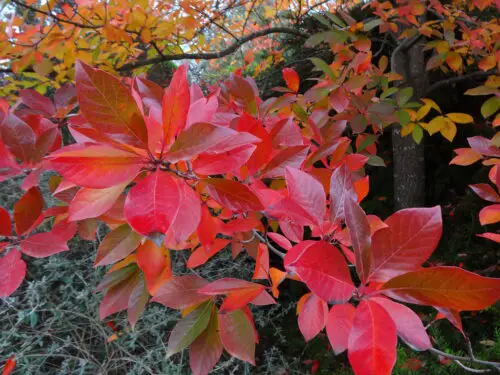
Beyond its seasonal charm, the black gum tree possesses inherent beauty that makes it an excellent choice as a specimen plant. In its early years, the tree typically assumes a pyramidal form, gracefully ascending towards the sky with a slender and symmetrical silhouette. This striking shape lends itself well to being a focal point in the landscape, drawing attention and admiration. As the black gum tree matures, its shape evolves into a more rounded and oval one, giving it a sense of maturity and grandeur. Regardless of its stage in life, the tree’s graceful architecture and impressive stature ensure it remains a captivating sight all year round.
Moreover, the black gum tree’s versatility allows it to complement a wide range of landscape styles. Whether used as a solitary accent piece in a formal garden or incorporated into a mixed planting scheme in a more naturalistic setting, the tree effortlessly enhances the overall visual appeal of its surroundings. Its adaptability to different environments and design concepts makes it a favorite among landscape designers and homeowners alike.
Aside from its aesthetic charm, the black gum tree also holds significant ecological value. It is native to various regions in North America, including parts of the eastern United States and southeastern Canada. As a native species, the black gum tree contributes to local ecosystems by providing habitat and sustenance for various wildlife species, including birds and insects. Additionally, the tree’s nectar-rich flowers attract pollinators, playing a crucial role in supporting biodiversity. Furthermore, the black gum tree is a resilient species that can tolerate wetter conditions, making it beneficial for stabilizing soils in riparian areas and protecting against erosion.
Caring for a black gum tree is relatively straightforward, making it an accessible option for even novice gardeners. While it prefers moist, well-draining soil, it can adapt to various soil types, from sandy to clay-based soils. Once established, the tree demonstrates a good level of drought resistance, reducing the need for frequent watering. Regular pruning is generally unnecessary, except for removing any dead or damaged branches, as the tree tends to maintain its natural shape and form without excessive intervention.
Pro: Adaptable to Wet Soils
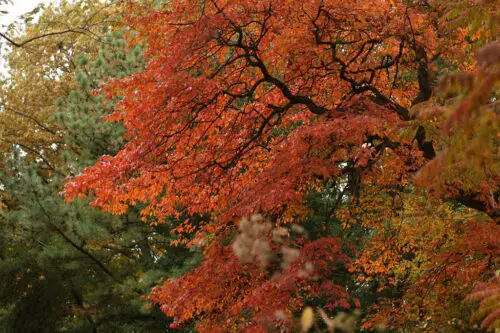
The black gum tree, scientifically known as Nyssa sylvatica, possesses a unique ability to adapt and thrive in various soil conditions, making it an incredibly desirable tree for landscaping projects in diverse environments. Unlike many other tree species, the black gum tree can flourish in moist soils, including low-lying areas or regions close to water sources, setting it apart and expanding its suitability for different planting locations.
One of the tree’s remarkable attributes is its capability to withstand brief floods, making it an ideal choice for areas with significant rainfall or occasional flooding. While other trees may struggle with waterlogged roots and succumb to root rot during flooding, the black gum tree’s root structure is well-adapted to handle such conditions, allowing it to withstand temporary inundation and continue thriving. This flood-tolerance makes it an excellent option for enhancing the beauty of landscapes in regions with high water tables or those prone to periodic water inundation.
Furthermore, the black gum tree’s adaptability extends to a variety of soil types, making it even more versatile in different settings. It can thrive in loamy soils, which offer a balanced combination of sand, silt, and clay, providing excellent nutrient retention and drainage capabilities. Additionally, the tree can flourish in acidic soils, making it well-suited for regions where the soil’s pH level may not be optimal for other tree species. Its ability to adapt to acidic conditions makes it particularly valuable in areas where acid-loving plants may struggle to grow.
The black gum tree’s adaptability also includes its tolerance to clay soils, which can be dense and have poor drainage. Unlike many trees that struggle in compacted or poorly drained soils, the black gum tree’s root system can penetrate clay soils, accessing essential nutrients and moisture even in challenging conditions. This adaptability to different soil types makes the black gum tree a hardy and flexible choice for landscape design, enabling it to thrive in various environmental conditions.
To ensure the proper development and health of the black gum tree, it is crucial to consider the specific soil characteristics of the chosen planting location. While the tree can adapt to various soil types, it does have preferences and optimal conditions for growth. Avoiding planting the black gum tree in compacted or poorly drained soil is essential, as these conditions can hinder root development and overall tree health. Compacted soil restricts root growth and limits the tree’s access to vital nutrients and water, resulting in stunted growth and a weakened tree.
Proper site preparation is key when planting a black gum tree. Amending the soil with organic matter can improve drainage and soil structure, creating a more favorable environment for the tree’s roots to grow and expand. Additionally, mulching around the base of the tree can aid in moisture retention and weed control, promoting healthier growth and reducing competition from invasive plants.
Once established, the black gum tree is relatively low-maintenance, requiring minimal interventions or specialized care. Regular inspections for pests, diseases, and other issues are recommended, as with any tree, to address problems early and ensure the tree’s continued vitality.
Pro: Low-Maintenance
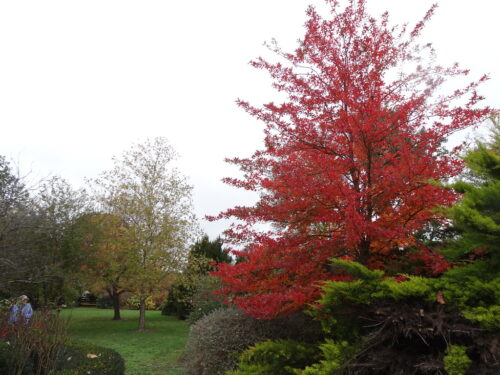
One of the key benefits of the black gum tree’s low-maintenance nature is its reduced need for regular fertilization and pruning. While many trees rely on periodic fertilizing to maintain their health and vigor, the black gum tree can often draw sufficient nutrients from its surroundings, including the soil and organic matter nearby. This self-sustaining quality allows the tree to grow and flourish without the constant need for fertilization.
Similarly, the black gum tree’s natural growth pattern and resilience to pests contribute to its minimal pruning requirements. Unlike certain trees that necessitate regular pruning to remove dead or overgrown branches, the black gum tree typically maintains a tidy appearance on its own, requiring less intervention from homeowners. Additionally, the tree’s relative pest resistance further reduces the need for extensive pruning, as it can withstand certain insect infestations and diseases more effectively than other species.
Though the black gum tree is generally low-maintenance, its initial years after planting may require a bit more attention to ensure healthy development. During this establishment period, consistent watering is crucial to ensure that the tree’s root system establishes itself adequately. Sufficient moisture is essential for the tree to develop strong roots and become well-established in its new environment. Regular watering, especially during dry spells or droughts, will assist the tree’s successful growth and survival.
Moreover, occasional trimming might be necessary in the early years to shape the tree and encourage proper branching. By selectively pruning some branches, the tree can be guided to develop an ideal structure and form. This not only enhances its aesthetic appeal but also contributes to its long-term health and stability.
One remarkable characteristic of the black gum tree is its shallow root structure. Unlike some trees with deep-reaching roots that can compete with other plants and trees for water and nutrients, the black gum tree’s shallow roots make it an excellent companion plant for other flora in your yard. The tree’s roots are less likely to encroach upon the root systems of neighboring plants, reducing competition and allowing for a more harmonious and diverse garden ecosystem.
Furthermore, the black gum tree’s adaptability and versatility enable it to coexist with a wide range of plants and shrubs. Its ability to thrive in various soil types and environmental conditions makes it an ideal addition to different landscape designs. Whether you have a formal garden with carefully curated plantings or a more naturalistic setting with a mix of flora, the black gum tree can seamlessly integrate into the landscape and enhance its overall beauty.
Pro: Long Lifespan
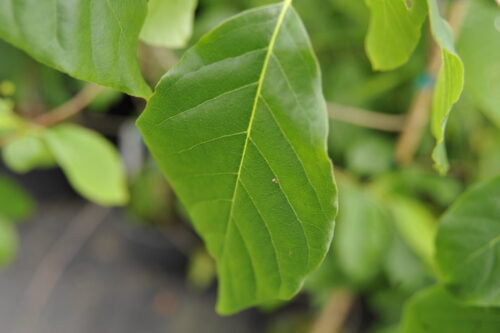
The black gum tree, scientifically known as Nyssa sylvatica, possesses a remarkable capacity to live for more than 700 years, making it one of the longest-living trees in North America. This exceptional lifespan has earned it the moniker of a “legacy tree,” symbolizing strength and endurance, and making it a valuable investment for the enjoyment of future generations.
To ensure the black gum tree thrives and reaches its full potential, it is crucial to carefully select an appropriate planting location. Optimal soil, sunlight, and moisture conditions are essential for the tree’s long-term health and vitality. Well-draining soil, consisting of a mix of sand, silt, and clay, provides the ideal foundation for the tree’s shallow root system to effectively access nutrients and moisture from the earth.
Adequate sunlight is vital for the black gum tree’s photosynthesis process, where it converts light energy into chemical energy, sustaining its growth and overall well-being. Planting the tree in an area with full to partial sunlight ensures it develops a robust and sturdy structure, setting the stage for its longevity.
Consistent and appropriate watering during the tree’s early years is paramount for establishing a healthy and resilient root system. While the black gum tree can endure short periods of drought once it is well-established, providing consistent irrigation during its establishment phase contributes to its ability to withstand environmental challenges as it matures.
To promote the tree’s longevity, regular trimming and upkeep are essential. Proper pruning helps remove any dead, diseased, or damaged branches, enabling the tree to allocate its resources efficiently towards healthy growth. Trimming also aids in shaping the tree’s structure, enhancing airflow and reducing the risk of potential issues, such as weak branches that may be prone to breakage.
Additionally, vigilance in identifying and addressing pest and disease problems early on is crucial. Pests and diseases can weaken the tree’s defenses and impact its overall health, potentially shortening its lifespan. Prompt action in dealing with these issues contributes to the tree’s continued vigor and resilience.
Beyond its impressive lifespan, the black gum tree’s existence as a legacy tree holds cultural, historical, and ecological significance. These ancient trees become habitats for various wildlife, offering shelter and sustenance for birds, insects, and other organisms. They serve as living landmarks, connecting the past with the present and preserving the memory of the land’s heritage.
Preserving and nurturing legacy trees like the black gum tree also play a vital role in environmental conservation and sustainability. Older trees contribute to carbon sequestration, helping mitigate climate change by absorbing and storing carbon dioxide from the atmosphere. Their extensive root systems aid in soil stabilization, preventing erosion and maintaining ecological balance within their ecosystems.
Furthermore, the black gum tree’s ability to provide shade and regulate temperatures in urban areas contributes to a more pleasant and sustainable environment. By reducing the heat island effect and cooling surrounding areas, these legacy trees enhance the well-being of city dwellers and promote a healthier urban habitat.
Pro: Provides Fruit
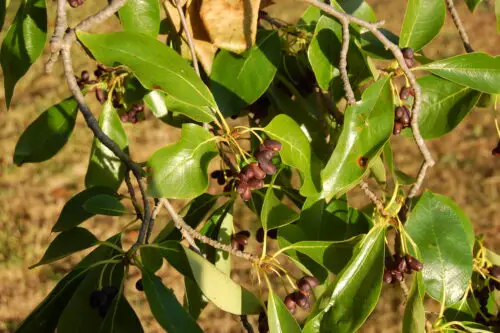
Wildlife, especially birds and squirrels, find the black gum tree’s fruit to be a valuable food source during this critical time of the year. As the colder months approach, these animals need to stock up on food to build up their energy reserves for winter survival. The small fruits are rich in nutrients, offering a nutritious and energy-packed meal that helps these creatures prepare for the challenges of the colder season.
Various bird species, such as robins, bluebirds, and thrushes, are particularly fond of the black gum tree’s fruit. The abundance of these tiny berries provides an essential food source for these songbirds, supporting their migration preparation and overall well-being.
Squirrels, including Eastern gray squirrels and fox squirrels, are also frequent visitors to the black gum tree when its fruit is in season. They actively forage and store the fruit, utilizing its nutritional content to fatten up for the colder months ahead.
Aside from its significance for wildlife, the black gum tree’s fruit is also edible and can be used in various culinary applications. When ripe, the fruit develops a rich blue-black color and offers a slightly sweet taste with subtle hints of spice.
Culinary enthusiasts can experiment with the unique flavors of the black gum fruit in the kitchen. Its naturally tangy profile makes it suitable for producing jams, jellies, and pies, adding a distinctive twist to traditional recipes. The tartness of the fruit, when balanced with sweeteners, creates a delightful flavor profile that pairs well with various dishes.
However, harvesting the black gum fruit for human consumption can pose a challenge. The fruit is relatively small and often hangs high on the tree’s branches. As a result, reaching the fruit for harvesting may require some effort and creativity. Specialized tools, such as long-handled fruit pickers or tree-climbing gear, may be necessary to access the high-hanging fruit.
Despite the challenges, the reward of savoring the black gum fruit’s unique flavors and contributing to culinary creativity makes the effort worthwhile for enthusiasts. Additionally, the fruit’s culinary potential offers a sustainable and locally-sourced alternative to traditional fruits, promoting a sense of connection to the natural world and the diversity it offers.
Pro: Used in Furniture and as a Shade Tree
The wood of the black gum tree is sturdy, long-lasting, and resistant to rot, making it a great material for flooring and furniture. Because of its thin texture, the wood is simple to carve and shape into various forms. Additionally, veneers, paneling, and cabinets are made from the tree’s wood.
The black gum tree is well-liked as a shade tree in addition to being used in furniture. It’s a great place to unwind or host visitors in the summer because of its wide canopy, which offers plenty of shade. By keeping your house cooler and decreasing the need for air conditioning, its shadow also helps redu ce energy expenses.
Pro: Non-Toxic to Pets
Before planting a tree species in your yard, it’s important for pet owners to consider the toxicity of the species. The good news is that pet owners may safely choose the black gum tree since it is non-toxic to animals.
The fruit of the tree is also safe for dogs to eat and does not affect them when ingested. Monitoring your dogs’ fruit diet is crucial since too much might disturb their digestive systems.
Pro: Attracts Deer
Planting a Black Gum Tree in Your Yard May Draw Deer to Your Property If You Enjoy Wildlife Watching. The tree is a great option for anyone interested in nature since deer are known to feed on its leaves and fruit.
Before planting a black gum tree, you should take this into consideration if you don’t want deer to roam freely around your yard. To keep deer out of your yard, you may need to take further steps like adding fence or repellents.
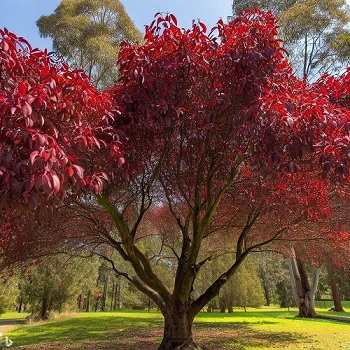
Con: Messy Fruit
For homeowners with busy schedules or limited time for yard maintenance, dealing with the fallen fruit can become a nuisance. Regularly picking up the fruit by hand can be time-consuming and labor-intensive, leading to potential frustration and neglect of this essential task. Additionally, if the fruit is not cleaned up promptly, it can attract unwelcome creatures like flies or rats, further adding to the inconvenience.
To address the issue of fallen fruit, strategic placement of the black gum tree in the yard can be beneficial. By situating the tree away from busy places like sidewalks or driveways, you can reduce the impact of the fallen fruit on high-traffic areas, keeping these spaces neater and more enjoyable for walking and other activities.
Moreover, taking proactive measures to manage the fallen fruit can make a significant difference. Instead of leaving the fruit on the ground, consider gathering and disposing of it in a compost or yard trash bin. This practice not only keeps the yard tidy but also allows for the organic matter to be recycled and contribute to composting efforts. Using a leaf blower or rake to collect the fruit can make the task more efficient and manageable, saving time and effort.
Aside from composting or disposal, the black gum tree’s fruit can have practical uses around the yard. Some homeowners may find creative ways to utilize the fallen fruit in cooking or baking. Although harvesting the fruit from the tree can be challenging, collecting the fallen fruit and exploring culinary possibilities can be a fun and rewarding experience. Incorporating the fruit into jams, jellies, or pies can not only be a delicious treat but also a way to make the most of the tree’s natural offerings.
Despite the potential challenges with the fallen fruit, it’s essential to remember the black gum tree’s numerous benefits. Its stunning aesthetics, longevity, and support for wildlife make it a valuable addition to any landscape. With proper management and a thoughtful approach to dealing with the fruit, homeowners can fully enjoy the tree’s beauty and advantages without being overwhelmed by the fallen fruit.
Con: Requires Ample Space for Roots
The extensive root system of the black gum tree is vital for its survival and overall health. These roots serve as essential anchors, providing stability and support against adverse weather conditions. Additionally, they absorb water and essential nutrients from the soil, contributing to the tree’s robust growth and long-lasting nature.
However, this very characteristic that ensures the black gum tree’s resilience and longevity can also present challenges in confined spaces. In small yards or limited areas, the expansive root system may encounter obstacles such as buildings, pavement, or other structures, hindering its growth or potentially causing damage.
Planting a black gum tree in a small yard can lead to stunted growth and underdevelopment. The roots may compete for limited resources, making it difficult for the tree to thrive and reach its full potential. In such scenarios, the tree may not exhibit the majestic beauty and size it would attain in a more appropriate location.
Moreover, planting a black gum tree close to a driveway or sidewalk can result in issues. As the roots continue to grow and expand, they may exert pressure on the pavement or driveway surfaces. Over time, this pressure can cause the pavement to elevate or develop fractures and cracks. Such pavement damage poses trip hazards for pedestrians and necessitates costly repairs to maintain the safety and integrity of the surfaces.
Furthermore, the extensive root system of the tree may seek moisture from the soil beneath nearby buildings. This can inadvertently lead to soil shrinkage and foundation settlement, potentially causing structural problems for buildings in close proximity to the tree.
To avoid these challenges, thoughtful planning of the planting location for a black gum tree is crucial. Ample space should be provided to accommodate the tree’s extensive root system without encroaching on nearby structures. Consulting with professionals, such as arborists or landscape experts, can help determine the ideal placement for the tree, considering available space and potential impacts on surrounding elements.
In situations where planting a black gum tree near a driveway or sidewalk is unavoidable, the use of root barriers can be a practical solution. These barriers are installed below ground to guide the tree’s roots away from vulnerable structures. By directing the roots downward instead of laterally, the risk of pavement or foundation damage can be significantly reduced.
Con: Hard to Find in Nurseries
Finding black gum trees (Nyssa sylvatica) in nurseries may be a bit more challenging than other tree varieties due to their relative rarity. However, they are still available in many nurseries and can even be ordered online. If you are having trouble locating a black gum tree at your local nursery, consider asking the staff to place a special order for you. Many nurseries have connections with suppliers and can accommodate specific customer requests.
In addition to nurseries, various reputable online plant retailers offer black gum trees for purchase. When buying online, ensure you choose a reliable source that provides healthy and well-established trees, so you can enjoy the beauty and benefits of your tree for years to come.
Once you have acquired your black gum tree, the next important step is selecting the best location for planting it in your region. Seeking advice from a nearby arborist or tree specialist can be highly beneficial in this regard. Arborists possess extensive knowledge about different tree species and can provide valuable insights into the ideal conditions and positioning for your black gum tree to thrive.
Considering factors such as soil type, sunlight exposure, and drainage will help you choose the perfect spot to accommodate the tree’s growth and enhance its beauty in your landscape. The black gum tree prefers moist, well-draining soil and partial to full sunlight for optimal growth. By factoring in your region’s specific climatic conditions and the tree’s potential size at maturity, you can create an environment where the tree will flourish.
With proper care and attention, your black gum tree will reward you with its stunning beauty and longevity. It will add a unique touch to your landscape and provide valuable benefits to wildlife as well. Remember to monitor the tree’s growth and health regularly, and consult with an arborist or tree specialist if you have any concerns or questions.
Con: Not Suitable for High Foot Traffic Areas
Planting black gum trees (Nyssa sylvatica) near areas with high foot activity, such as sidewalks or driveways, requires careful consideration due to their extensive root systems. While these trees are prized for their beauty and benefits, their roots can present challenges, potentially causing trip hazards and pavement damage that could be hazardous for pedestrians and vehicles.
The expansive root system of the black gum tree is essential for its stability and longevity. As the tree grows, its roots seek out water and nutrients from the surrounding soil, extending far beyond the tree’s canopy. When planted too close to paved surfaces like sidewalks or driveways, the roots may encounter these solid structures, leading to potential issues.
One concern is the possibility of raised pavement caused by the tree’s roots growing beneath sidewalks or driveways. These uneven surfaces can be challenging to detect and increase the risk of accidents and injuries, especially in areas with heavy foot traffic.
Another issue arises from the pressure exerted by the roots on the pavement, which can lead to fissures and cracks in the concrete or asphalt. As the roots continue to grow and expand, they may push against the hard surfaces, causing damage over time. Cracked pavement not only compromises the appearance of the area but also necessitates costly repairs, causing inconvenience to property owners.
To prevent such problems, seeking advice from a qualified arborist or landscaper before planting a black gum tree near busy areas is essential. These experts possess in-depth knowledge about tree species and can offer valuable guidance on suitable planting locations to avoid potential conflicts with sidewalks, driveways, or other structures.
An arborist or landscaper can assess the available space and recommend appropriate areas for planting, ensuring that the black gum tree has enough room for its roots to spread without causing damage to nearby paved surfaces. They may also suggest alternative tree species with less aggressive root growth patterns for areas with high foot activity, reducing the likelihood of pavement damage and trip hazards.
Furthermore, these professionals can advise on proper planting techniques and maintenance practices to minimize the risks associated with the tree’s roots. They may recommend the use of root barriers to guide the roots away from paved surfaces, providing an effective solution to prevent potential damage.
Con: Slow Growth Rate

Since black gum trees develop slowly[1], it can take the tree a long time to attain its full potential. For those looking for a tree that would soon provide shade or seclusion, the typical annual growth rate of black gum trees is just 1 to 2 feet, which might be discouraging.
It’s crucial to plant your black gum tree in a good area with the ideal soil, sunshine, and moisture conditions if you want it to develop at a healthy pace. Regular fertilization and irrigation may also support strong development.
How to Care for Black Gum Trees
It’s critical to understand correct maintenance procedures. Here are some pointers for maintaining black gum trees:
Sunlight and Soil Requirements
The optimal conditions for growing black gum trees are full sun to partial shade, acidic, medium to moist, well-drained soils. They are a fantastic option for low-lying regions of the landscape since they are designed to flourish in moist soils. They can even grow organically in arid locations and can withstand mild drought.
Fertilizing and Watering
You should irrigate the soil twice a week while a black gum tree is young. It will expand its root system as it gets bigger, enabling it to withstand dry spells. Feed the tree every year with a slow-release granular fertilizer in the fall. For every inch of trunk diameter, use 2 cups of fertilizer.
Pruning
If you want a black gum tree with a lovely, even form, you can trim it. Prior to the onset of new growth, the tree should be pruned in late winter or early spring. Branches that are crossing or rubbing against one another should be thinned out, and those that are dead, diseased, or broken should be removed.
Control of Pests and Disease
Although black gum trees are often resistant to pests and diseases, some problems may still damage them. The tree may get infected with insects like scale and aphids as well as diseases like leaf spot and canker. Watch for any indications of a pest problem or a sickness and respond right away.
How To Choose The Right Tree
It’s crucial to make the perfect choice when selecting a tree for your yard or property, so don’t skimp on this step. In addition to enhancing the aesthetics of your landscape, trees also provide shade, enhance the quality of the air, and raise the value of your home. Planting the incorrect tree in the incorrect location, however, may have unfavorable cons, such as harm to buildings, walkways, and roads, or interference with electricity lines. The following advice and considerations may help you choose the ideal tree:
- Think about your hardiness zone: When trees are planted in the proper location, they flourish. To learn which trees may be planted in your location, determine your hardiness zone. Consult the Arbor Day Foundation or your neighborhood nursery to learn how to accomplish this.
- Sizing out the growth area is important before selecting a tree. Make sure the tree won’t interfere with structures, walkways, or power lines by taking into account the height and spread it will have at maturity. Be mindful of the area required for the tree’s roots to expand.
- Soil conditions: When selecting a tree, homeowners should take the soil into consideration. Different soil types and pH levels are preferred by various trees. Make sure the soil has good drainage since excessive wetness might cause root rot.
- Consider the purpose that the tree will serve. Do you want visual appeal, solitude, or shade? Pick a tree that can meet your demands.
- Match the tree’s growth environment to the circumstances. Take into account how much sun, wind, and moisture the tree will experience. Make sure it is appropriate for your climate and soil.
- Think about outdoor living spaces: Consider how the tree will affect outdoor living spaces. Does it provide the desired shade or impede views? Will it produce debris like fruit or leaves that has to be cleaned up?
- Maintenance: Take into account how much upkeep the tree will need. Does it need frequent watering or pruning? Will it attract bugs or illnesses?
You may choose the ideal tree for your home that will improve its attractiveness and provide benefits for many years by taking these pros and cons into account. Making the ideal decision for your landscape also benefits from seeking advice from a nearby arborist or nursery.
Wildfire Black Gum tree
The Wildfire Black Gum tree, sometimes called Nyssa sylvatica ‘Wildfire,’ is a deciduous tree with an extraordinary and beautiful pyramidal form. It is a rapidly expanding tree that may grow as tall as 60 feet and as wide as 30 feet. For gardeners seeking a striking and low-maintenance addition to their landscape, this tree is a popular option.
Its captivating variety of hues is one of the Wildfire Black Gum tree’s most alluring qualities. This tree’s leaves may be red, orange, or even purple, all on the same tree. The leaves change color throughout the year, going from a vibrant green in the early spring to a dark green in the summer, and then in the fall, they put on a spectacular show of red, purple, gold, and orange. This tree is a sight to see all through the growing season since the new growth is likewise red.
Several nurseries, including fast-growing-trees.com, Oakland Nurseries, Nature Hills Nursery, Brighter Blooms, and New Blooms Nursery, among others, sell the Wildfire Black Gum tree for sale. Customers may choose from a variety of sizes and container choices, and some nurseries offer free shipping and 30-day returns. Prices vary from $25.99 for a 3-4 foot tree from TN Nursery to $574.50 for a BAG 2-2.5″ CAL tree from lfplantoutlet.com.
It is a native tree that thrives in consistently moist soils; it prefers full sun to partial shade; it can grow in a variety of soil types, including clay, loam, and sand; and it generally doesn’t need much pruning. Black Gum trees are relatively low-maintenance and their average texture blends well into the landscape.
Black gum tree lifespan
One of the East’s most durable trees, the black gum tree has a lifetime that may reach 700 years.
The black gum tree is the longest-living non-clonal flowering plant in eastern North America, with a lifespan that can range from 150-300 years to over 650 years, according to various sources. This species of hardwood is found to thrive in the eastern United States, growing at very low densities, and capable of achieving ages of over 650 years. It grows at a slow rate, gaining only 1 to 2 feet per year. It prefers moist soil and does best in full sun to partial shade
The small blue-black fruit that the black gum tree produces are a valuable food source for wildlife, including songbirds, squirrels, and deer, and are produced inconspicuously by the tree’s inconspicuous flowers in late summer and early fall.
The black gum tree has a long history of use in traditional medicine, and some parts of the tree have been used to treat fever, coughs, and other ailments. However, the tree is not frequently used for lumber because it is a relatively small tree and has a tendency to grow crooked. However, it is occasionally used for furniture, flooring, and interior trim.
Where do you buy Black gum tree
Numerous nurseries and garden stores sell Black Gum trees. Black Gum trees are sold by several internet merchants, who may delivery them to your area. You may go online for businesses that specialize in selling trees and plants to find local nurseries and garden stores in your region that offer Black Gum trees. Make that your tree is a healthy, high-quality plant and that you get it from a dependable vendor. When selecting the best Black Gum tree for your landscaping, you should also consider pros and cons including the tree’s mature size and growth pace, as well as your local climate and soil conditions.
Conclusion
I hope you find this article “Black Gum Tree Pros and Cons” helpful. Many homeowners find the tree to be an appealing option due to its aesthetic value, capacity to grow in damp soils, minimal care requirements, and long lifetime. The tree also attracts deer and produces fruit that is tasty to animals and non-toxic to pets.
The black gum tree does have some disadvantages, too, such messy fruit, a need for plenty of area for roots, and a sluggish rate of development. It may also be difficult to locate in nurseries and is not recommended for places with heavy foot traffic.
Consider the size, location, and soil conditions of your yard before planting a black gum tree there. You should also think about your own preferences and yard-related objectives. Your black gum tree may flourish and give benefits for many years with the right planning, routine maintenance, and care.
Related Posts:
Redbud Trees Pros and Cons – 12 Facts You Need to Know
Chinese Pistache Tree Pros and Cons – 8 Facts You Need to Know
